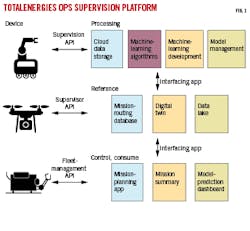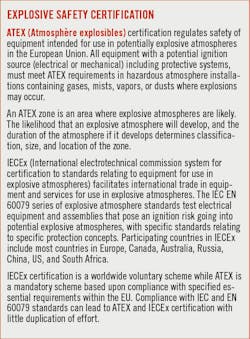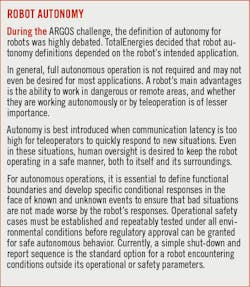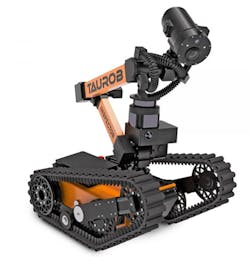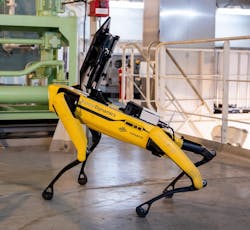Work-class robots are being used offshore following the autonomous robots for gas and oil sites (ARGOS) robotics competition. ARGOS spurred development in offshore compatible robots and digital platforms with onshore supervision. TotalEnergies E&P UK (TEPUK), Equinor ASA, Aker BP ASA, bp PLC, and Petronas Carigali Sdn Bhd leveraged ARGOS to implement offshore robot pilot projects for inspections, gauge readings, facility scans, and equipment manipulation.
ARGOS challenge
In 2013 TEPUK led the ARGOS joint industry project to set a 2024 deadline for introducing autonomous offshore work-class robots that “operate in a low-complexity production site like a wellhead platform of a well pad.” TotalEnergies envisions three types of robots for this application: surveillance robots for facility observation, simple robots for routine operating tasks, and complex handling robots for maintenance tasks.
In 2018-20 the Offshore Ground Robots Industrial Pilot (OGRIP) program, funded by TotalEnergies and the Oil and Gas Technology Centre (OGTC), created an ATEX Zone-1 (see Box 1) certified offshore work-class robot with Taouob GMBH, winner of ARGOS, and Total-owned battery maker Saft. The ATEX lithium-ion battery energy range is 500–1,000 W-hr and operates in harsh offshore conditions with temperatures between -30 °C. and +60 °C. The robot included interchangeable light- and heavy-duty arms, universal interfaces for attachments such as gas sensors and light detection and ranging (LIDAR), and unsupervised autonomy capabilities (see Box 2).
The ARGOS challenge proved that wireless robot performance directly depends on the quality of communication to interfacing remote digital architecture. An early 10-day offshore test in high humidity and temperature environments resulted in 25% robot downtime from communication and hardware failures, with another 10% downtime due to extreme weather conditions. High-quality wireless communication is therefore critical with bandwidth and latency defining real-time functionality. TotalEnergies handles robot communication through 4G or 5G LTE protocols. Other systems use Wi-Fi or radio frequency, the latter considered the most robust by Cognite AS who is working on robotic systems for Aker BP.
Robot supervision
Robot on-board storage and processing power is limited. Offloading analysis and decision processes to edge or cloud-based systems promotes higher processing speeds and more functionality. Battery consumption also decreases, extending range. To address these issues, TEPUK developed a digital architecture that promotes universal connectivity with robots, mobile devices, or Internet of Things (IoT) sensor platforms. The architecture reviews digital communication quality, data criticality, file size, and virtual machine processing costs to decide whether to process data in batch mode or real time.
The digital platform, called OpsSuperVision, consists of data processing, single-source truth reference, and device control and data consumption (Fig. 1). Application interfaces communicate between the layers.
The processing layer contains machine learning (ML) models, cloud data, and general management of data and models. Uploaded data from robots or devices are processed at this level. It interfaces with reference-layer digital twins and pushes processed results to the reference data area (data lake) for storage and later processing.
The reference layer includes a digital twin, mission routing databases, and the data lake. It is the central core of the operating system. The digital twin models physical assets and continuously updates to provide a single data reference point, or “source of truth,” for operations. The mission-routing database stores details of functions that devices (robots, handhelds, etc.) perform, including location information for navigation and data collection. The data lake stores results from ML models. Combined, this layer provides a consistent method of accessing and using qualified historic asset information.
The control-and-consume layer manages planning, monitoring, and reporting for devices. End-user interfaces include mission planning applications, mission summaries, and model prediction dashboards. Device missions are planned and sent to the device remotely using the mission planning application which interfaces with the digital twin and mission routing database in the reference layer. The mission-summary dashboard provides onboard robot-health monitoring including failures and safety-related issues in real-time or post-mission. The model-prediction dashboard provides operator review of robot and device sensors and ML-model results pulled from the data lake.
Application program interfaces (APIs) connect devices, components, and layers together. Fleet management APIs call actions for the robot, providing at minimum a method for pushing single missions to the device and providing ongoing telemetry for device location and status. The fleet management API is limited to coordinates or points of interest. Supervisor API combines digital-twin data with operator requests to allow third-party data collection systems and devices to perform data-collection missions. The digital twin provides location information, used by the fleet management API for navigation, and the supervisor API provides context for the mission with function requirements for inspection and operation.
A supervision API uploads data to storage in the processing layer. The API is also responsible for triggering real-time batch processing of sensor data through the ML models and transferring device data from cloud storage to the data lake. A quantum ML API retrieves information from the digital twin and identifies locations in the data lake for ML results and device mission data.
TotalEnergies created a new “Operation Room” function to interface robot activities with the off-site control room (Fig. 2). The operation room is adjacent to the control room and enables supervision and coordination of all remote mobile systems (unmanned aerial vehicles, ground-based robots, underwater robotic remotely operated vehicles, etc.). Operation room personnel oversee the fleet management system (FMS) in charge of sequencing robot and drone activities. Other duties include robot control for complex non-autonomous tasks, maintenance and repair of the FMS, and maintenance and repair of the robots.
While these systems may ultimately be autonomous, robot panel operators will always continually monitor the fleet and interact accordingly. Expertise from production and maintenance operators and vessel crews will ultimately leave the field and relocate to the operation room, ultimately reducing on site incidence rate (IR).
Large offshore production infrastructure, such as floating, production, storage, and offloaing (FPSO) vessels and platforms, have about 3-4 ✕ 10-4 IR/year, translating to about 3-4 fatalities every 10 years at a site where personnel on board (POB) is more than 100. New requirements from several national company developmental projects require 1 ✕ 10-4 IR for project sanction. Relocating POB to the operation room is one method to achieve this end.
Offshore installations
Total Netherlands claimed first use of an offshore autonomous ATEX Zone 1-compliant robot in August 2020 in the condensate recovery area of its K5 Central Complex offshore gas production site, Block K5, Dutch sector of the North Sea. The “Stevie-1” tracked inspection robot was supplied by Taurob for long-term evaluation in performing tasks like external corrosion and painting inspection.
Initial problems included robot tracks tearing apart on open grates and closed-door windbreaks standing in the way. These problems were addressed with revised tracks and door-opening technology. After a brief scan, Stevie-1 demonstrated localization, navigation, and data collection capabilities. Paint and corrosion surveys shortly followed.
TotalEnergies increased robot complexity with Taurob’s “Stevie-2”, which included a heavy-duty arm to handle simple operations like turning manual valves (Fig. 3). It deployed late-2021 to test durability and functionality in an unmanned site, where the robot would be expected to require only annual maintenance. The robot directly integrated with TotalEnergies system architecture and was controlled from an onshore control room. Taurob claims to have performed the largest-area autonomous mapping and inspection by robot of an offshore platform.
Equinor, partner in the ARGOS JIP, began its long-term testing of a Taurob Inspector robot for routine inspection and maintenance tasks in the Johan Sverdrup field in late 2020. Initial testing used simulations carried out by a 3D model of the robot and the production site’s Echo digital twin to determine the robot’s maneuverability and reaction in the environment. Land-based processing facility tests followed at Equinor’s lab in Kårstø before deploying the first robot offshore in April 2021.
The robot is equipped with an arm to support a regular or infrared camera for inspection. At Kårstø, it operated autonomously to a set inspection route and predetermined tasks. On Johan Sverdrup, it performs regular inspection one deck at a time and obtains pictures and sound recordings at fixed locations. It is also equipped with a gas detector. The robot is expected to make observations and recordings more regularly and accurately than those previously done manually. More advanced uses are expected over time.
Aker BP tested Boston Dynamic’s Spot quadruped robot on site to understand its performance in autonomous inspection, high-quality data capture, and automatic reporting (Fig. 4). Spot is not yet ATEX compliant. Tests evaluated the robot’s ability to provide onshore operators an offshore presence for routine inspection, including in locations humans cannot enter or enter safely.
Cognite’s data fusion platform (CDF) now serves as Spot’s cloud-based data operations and intelligence platform, integrating with cloud, edge, and on-premises applications. CDF collects images, scans, and sensors from robotics systems and shares data across Aker BP sites.
Spot has an internal point-cloud navigation system using onboard imaging and recognition for autonomous operation. Using this system, alarms, for example, can be addressed by pushing the event’s location or equipment ID from CDF to the robot for investigation. Using its internal guidance, the robot can navigate to the alarm without having to reference GPS.
One of Spot’s main purposes is data collection (e.g. gauge reading and visual inspection), a less expensive option than outfitting large brownfield sites with full remotely monitored instrumentation. Scans from Spot also update digital twins with LIDAR-tracked structural changes.
A version of Spot was taken onto Aker BP’s Skarv FPSO, 210 km offshore in the North Sea, to test its data collection, mobility, and communications to CDF and Aker BP. As a part of the test the robot was remotely controlled from an onshore home office with data from Spot available and sorted in CDF in milliseconds. Data from an operator round were collected to determine if Spot’s sensor stack was sufficient for the tasks assigned to it.
bp deployed a SPOT on its Mad Dog platform in the Gulf of Mexico. The company’s objective for robots on offshore rigs is to remove employees from potentially hazardous situations and physically demanding environments like enclosed or elevated spaces. The robot performs routine inspection tasks and identifies leaks and corrosion with audio, video, and methane sensors.
The robot is monitored and operated mostly remotely using a data and operations platform from Formant. A single dashboard collects, consolidates, and visualizes all data obtained during an inspection for human subject-matter expert review and analysis. The central command center leverages one expert over several robot installations.
Initial proof of concept was performed at Texas A&M Engineering Extension Service (TEEX) near Fort Worth, Tex. Mobility tests included gravel pads and ramps, narrow passages, confined spaces, and grated platforms. Spot’s perception system did not perform well on grated stairs, and Boston Dynamics revised the system to improve that function. A week-long deployment at bp’s Whiting refinery near Chicago tested Spot’s mobility in a live production setting, autonomous functions, and communication integration with the site. It was subsequently deployed offshore for further communication integration and functionality tests. The robot is currently used in manual and semiautonomous modes but will include more autonomous functions and analytical reasoning to interpret gathered data.
Petronas performed a multi-week test of an ANYBotic AG ANYmal C four-legged walking robot for routine inspections on its Dulang B platform, 200 km offshore Malaysia (Fig. 5). Tasks included general visual inspection, digital readout of analog and digital gauges, thermography, and acoustic analysis of rotating equipment. The robot has LIDAR, a visual camera with optical zoom, a thermal camera, ultrasonic microphone, and LED spotlight.
ANYmal C is not ATEX certified, restricting offshore tests to a three-floor water injection module. Conditions included slippery terrain, strong winds, and both day and night operations. The LIDAR-based localization of ANYmal was successful under all conditions. All functionalities were confirmed, including autonomous charging on a docking station. Petronas and ANYbotics are co-developing a certified version of ANYmal for potentially explosive environments.
Bibliography
Armstrong, L.A., “Artificial Intelligence and Robotics in the Oil Industry: Will it Take My Job?” SPE-204643-MS, SPE Middle East Oil and Gas Show and Conference, Manama, Bahrain, Nov. 28- Dec. 1, 2021.
Equinor, “Our first autonomous robot,” loop stories, equinor.com.
Kydd, K., Brennan, D., Merkle, N.K., and Wright, M., “Robotics, Digital Twins and AI: Connecting the Dot Matrix,” SPE-205409-MS, SPE Offshore Europe Conference and Exhibition virtual, Sept. 7-10, 2021.
Kydd, K., Macrez, and S., Pourcel, “Autonomous Robot for Gas and Oil Sites,” SPE-175471-MS, SPE Offshore Europe Conference and Exhibition, Aberdeen, UK, Sept. 8-11, 2015.
Maslin, E., “ROBOTICS: Meet your New Offshore Robotic Co-workers; Charles, Eddie, ANYmal & Spot,” Offshore Engineer, Aug. 3, 2021.
Munoz, J-M, Bartoli, E., and Macrez, S., “Operation Room: A Key Component for Upscaling Robotic Solutions in Site,” SPE-202667-MS, Abu Dhabi International Petroleum Exhibition and Conference, Abu Dhabi, Nov. 9-12, 2020.
Total, “Ground Robotics for Next Generation Facilities,” ARGOS project brochure, 2014-2020.
TotalEnergies, “The Argos Project: Autonomous Robots for Gas and Oil Sites,” TotalEnergies.com.
About the Author
Alex Procyk
Upstream Editor
Alex Procyk is Upstream Editor at Oil & Gas Journal. He has also served as a principal technical professional at Halliburton and as a completion engineer at ConocoPhillips. He holds a BS in chemistry (1987) from Kent State University and a PhD in chemistry (1992) from Carnegie Mellon University. He is a member of the Society of Petroleum Engineers (SPE).
